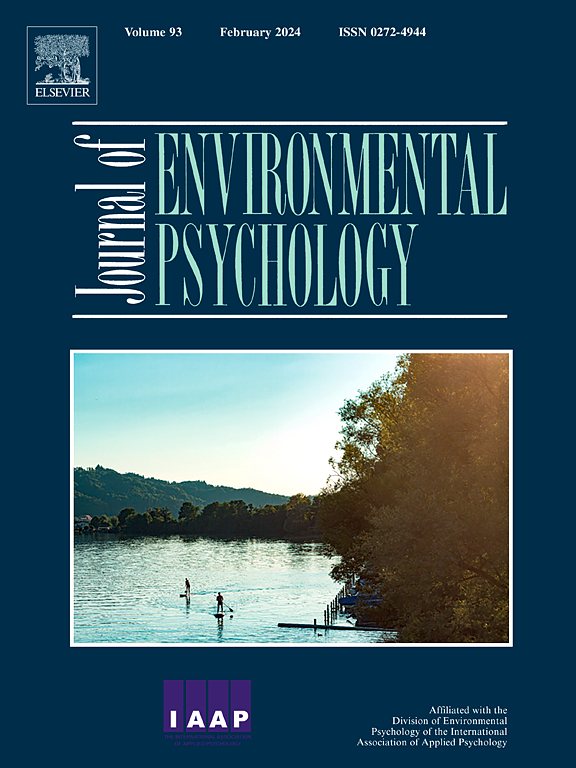In the ear of the beholder: Restorative potential of different audio-visual characteristics of recreational spaces tested in 360° VR
IF 7
1区 心理学
Q1 ENVIRONMENTAL STUDIES
引用次数: 0
Abstract
Nature has been linked to various psychophysiological benefits for human restoration from long- and short-term stress. However, progressing urbanization and noise pollution threaten the restorative potential of recreational spaces. The question arises which characteristics of recreational spaces are particularly important for restoration. In this experimental VR study, which utilized 360° video and third-order ambisonics, 37 participants were immersed in 18 restoration environments with varying audio-visual characteristics in terms of visual setting (forest, lake, urban built space), soundscape (natural, anthropogenic), and sound pressure level (low, medium, high). Psychological ratings (acoustic quality, overall restorative potential) and physiological responses (changes in skin conductance level as a biomarker for stress) were assessed. The results simultaneously highlight the beneficial links of natural land- and soundscapes, and the adverse links of built environments and anthropogenic noise, with restoration: (1) The highest restorative potential was observed in scenarios where both auditory and visual features were natural (e.g., a forest or lake featuring birdsong and wind); (2) Introducing a built environment and/or an anthropogenic soundscape decreased restorative potential; (3) The lowest psychological and physiological restoration was observed in built spaces with anthropogenic soundscapes; and (4) Increasing sound pressure level was associated with lower restorative potential only for anthropogenic soundscapes, but not for natural ones. These findings underscore the detrimental associations of noise pollution, particularly with the restorative qualities of natural environments, and highlight the importance to provide access to recreational spaces with natural land- and soundscape features to promote population health.
在旁观者的耳朵里:在360°VR中测试娱乐空间的不同视听特征的恢复潜力
大自然与人类从长期和短期压力中恢复的各种心理生理益处有关。然而,不断发展的城市化和噪音污染威胁着休闲空间的恢复潜力。问题是,休闲空间的哪些特征对恢复特别重要。在这项利用360°视频和三阶立体声技术的VR实验研究中,37名参与者沉浸在18个视觉环境(森林、湖泊、城市建筑空间)、声景(自然、人为)和声压级(低、中、高)等不同视听特征的修复环境中。评估心理评分(声学质量,整体恢复潜力)和生理反应(皮肤电导水平的变化作为应激的生物标志物)。研究结果同时强调了自然土地景观和声景观的有利联系,以及建筑环境和人为噪声的不利联系:①在听觉和视觉特征都是自然的场景中(例如,有鸟鸣和风的森林或湖泊),观察到最高的恢复潜力;(2)引入已建成环境及/或人为声景,降低修复潜力;(3)有人为声景的建筑空间的心理和生理恢复程度最低;(4)声压级的增加只与人为声景观的恢复电位降低有关,而与自然声景观的恢复电位无关。这些研究结果强调了噪音污染的有害联系,特别是与自然环境的恢复性质的联系,并强调了提供具有自然土地和声景特征的娱乐空间的重要性,以促进人口健康。
本文章由计算机程序翻译,如有差异,请以英文原文为准。
求助全文
约1分钟内获得全文
求助全文
来源期刊

Journal of Environmental Psychology
Multiple-
CiteScore
10.60
自引率
8.70%
发文量
140
审稿时长
62 days
期刊介绍:
The Journal of Environmental Psychology is the premier journal in the field, serving individuals in a wide range of disciplines who have an interest in the scientific study of the transactions and interrelationships between people and their surroundings (including built, social, natural and virtual environments, the use and abuse of nature and natural resources, and sustainability-related behavior). The journal publishes internationally contributed empirical studies and reviews of research on these topics that advance new insights. As an important forum for the field, the journal publishes some of the most influential papers in the discipline that reflect the scientific development of environmental psychology. Contributions on theoretical, methodological, and practical aspects of all human-environment interactions are welcome, along with innovative or interdisciplinary approaches that have a psychological emphasis. Research areas include: •Psychological and behavioral aspects of people and nature •Cognitive mapping, spatial cognition and wayfinding •Ecological consequences of human actions •Theories of place, place attachment, and place identity •Environmental risks and hazards: perception, behavior, and management •Perception and evaluation of buildings and natural landscapes •Effects of physical and natural settings on human cognition and health •Theories of proenvironmental behavior, norms, attitudes, and personality •Psychology of sustainability and climate change •Psychological aspects of resource management and crises •Social use of space: crowding, privacy, territoriality, personal space •Design of, and experiences related to, the physical aspects of workplaces, schools, residences, public buildings and public space
 求助内容:
求助内容: 应助结果提醒方式:
应助结果提醒方式:


